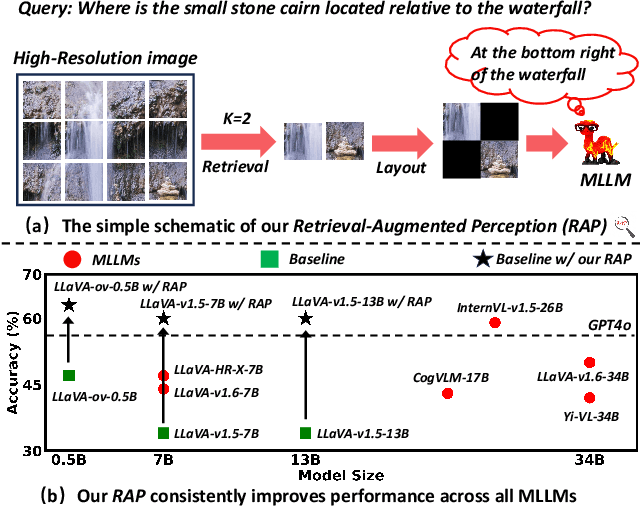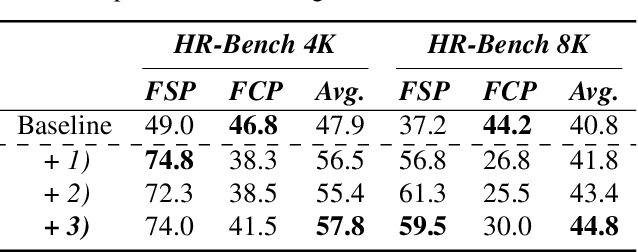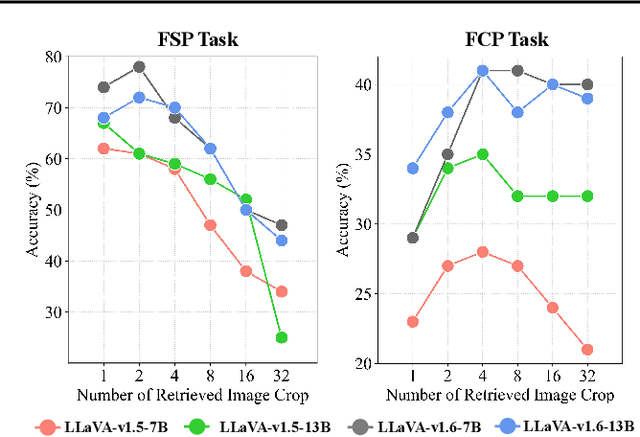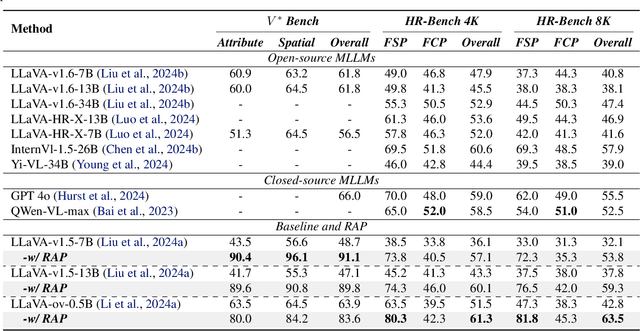Yong Luo
REX-RAG: Reasoning Exploration with Policy Correction in Retrieval-Augmented Generation
Aug 12, 2025Abstract:Reinforcement learning (RL) is emerging as a powerful paradigm for enabling large language models (LLMs) to perform complex reasoning tasks. Recent advances indicate that integrating RL with retrieval-augmented generation (RAG) allows LLMs to dynamically incorporate external knowledge, leading to more informed and robust decision making. However, we identify a critical challenge during policy-driven trajectory sampling: LLMs are frequently trapped in unproductive reasoning paths, which we refer to as "dead ends", committing to overconfident yet incorrect conclusions. This severely hampers exploration and undermines effective policy optimization. To address this challenge, we propose REX-RAG (Reasoning Exploration with Policy Correction in Retrieval-Augmented Generation), a novel framework that explores alternative reasoning paths while maintaining rigorous policy learning through principled distributional corrections. Our approach introduces two key innovations: (1) Mixed Sampling Strategy, which combines a novel probe sampling method with exploratory prompts to escape dead ends; and (2) Policy Correction Mechanism, which employs importance sampling to correct distribution shifts induced by mixed sampling, thereby mitigating gradient estimation bias. We evaluate it on seven question-answering benchmarks, and the experimental results show that REX-RAG achieves average performance gains of 5.1% on Qwen2.5-3B and 3.6% on Qwen2.5-7B over strong baselines, demonstrating competitive results across multiple datasets. The code is publicly available at https://github.com/MiliLab/REX-RAG.
Demonstration of Efficient Predictive Surrogates for Large-scale Quantum Processors
Jul 23, 2025Abstract:The ongoing development of quantum processors is driving breakthroughs in scientific discovery. Despite this progress, the formidable cost of fabricating large-scale quantum processors means they will remain rare for the foreseeable future, limiting their widespread application. To address this bottleneck, we introduce the concept of predictive surrogates, which are classical learning models designed to emulate the mean-value behavior of a given quantum processor with provably computational efficiency. In particular, we propose two predictive surrogates that can substantially reduce the need for quantum processor access in diverse practical scenarios. To demonstrate their potential in advancing digital quantum simulation, we use these surrogates to emulate a quantum processor with up to 20 programmable superconducting qubits, enabling efficient pre-training of variational quantum eigensolvers for families of transverse-field Ising models and identification of non-equilibrium Floquet symmetry-protected topological phases. Experimental results reveal that the predictive surrogates not only reduce measurement overhead by orders of magnitude, but can also surpass the performance of conventional, quantum-resource-intensive approaches. Collectively, these findings establish predictive surrogates as a practical pathway to broadening the impact of advanced quantum processors.
Text-promptable Object Counting via Quantity Awareness Enhancement
Jul 09, 2025Abstract:Recent advances in large vision-language models (VLMs) have shown remarkable progress in solving the text-promptable object counting problem. Representative methods typically specify text prompts with object category information in images. This however is insufficient for training the model to accurately distinguish the number of objects in the counting task. To this end, we propose QUANet, which introduces novel quantity-oriented text prompts with a vision-text quantity alignment loss to enhance the model's quantity awareness. Moreover, we propose a dual-stream adaptive counting decoder consisting of a Transformer stream, a CNN stream, and a number of Transformer-to-CNN enhancement adapters (T2C-adapters) for density map prediction. The T2C-adapters facilitate the effective knowledge communication and aggregation between the Transformer and CNN streams. A cross-stream quantity ranking loss is proposed in the end to optimize the ranking orders of predictions from the two streams. Extensive experiments on standard benchmarks such as FSC-147, CARPK, PUCPR+, and ShanghaiTech demonstrate our model's strong generalizability for zero-shot class-agnostic counting. Code is available at https://github.com/viscom-tongji/QUANet
SRD: Reinforcement-Learned Semantic Perturbation for Backdoor Defense in VLMs
Jun 05, 2025Abstract:Vision-Language Models (VLMs) have achieved remarkable performance in image captioning, but recent studies show they are vulnerable to backdoor attacks. Attackers can inject imperceptible perturbations-such as local pixel triggers or global semantic phrases-into the training data, causing the model to generate malicious, attacker-controlled captions for specific inputs. These attacks are hard to detect and defend due to their stealthiness and cross-modal nature. By analyzing attack samples, we identify two key vulnerabilities: (1) abnormal attention concentration on specific image regions, and (2) semantic drift and incoherence in generated captions. To counter this, we propose Semantic Reward Defense (SRD), a reinforcement learning framework that mitigates backdoor behavior without prior knowledge of triggers. SRD uses a Deep Q-Network to learn policies for applying discrete perturbations (e.g., occlusion, color masking) to sensitive image regions, aiming to disrupt the activation of malicious pathways. We design a semantic fidelity score as the reward signal, which jointly evaluates semantic consistency and linguistic fluency of the output, guiding the agent toward generating robust yet faithful captions. Experiments across mainstream VLMs and datasets show SRD reduces attack success rates to 5.6%, while preserving caption quality on clean inputs with less than 10% performance drop. SRD offers a trigger-agnostic, interpretable defense paradigm against stealthy backdoor threats in multimodal generative models.
Refining Few-Step Text-to-Multiview Diffusion via Reinforcement Learning
May 26, 2025Abstract:Text-to-multiview (T2MV) generation, which produces coherent multiview images from a single text prompt, remains computationally intensive, while accelerated T2MV methods using few-step diffusion models often sacrifice image fidelity and view consistency. To address this, we propose a novel reinforcement learning (RL) finetuning framework tailored for few-step T2MV diffusion models to jointly optimize per-view fidelity and cross-view consistency. Specifically, we first reformulate T2MV denoising across all views as a single unified Markov decision process, enabling multiview-aware policy optimization driven by a joint-view reward objective. Next, we introduce ZMV-Sampling, a test-time T2MV sampling technique that adds an inversion-denoising pass to reinforce both viewpoint and text conditioning, resulting in improved T2MV generation at the cost of inference time. To internalize its performance gains into the base sampling policy, we develop MV-ZigAL, a novel policy optimization strategy that uses reward advantages of ZMV-Sampling over standard sampling as learning signals for policy updates. Finally, noting that the joint-view reward objective under-optimizes per-view fidelity but naively optimizing single-view metrics neglects cross-view alignment, we reframe RL finetuning for T2MV diffusion models as a constrained optimization problem that maximizes per-view fidelity subject to an explicit joint-view constraint, thereby enabling more efficient and balanced policy updates. By integrating this constrained optimization paradigm with MV-ZigAL, we establish our complete RL finetuning framework, referred to as MVC-ZigAL, which effectively refines the few-step T2MV diffusion baseline in both fidelity and consistency while preserving its few-step efficiency.
Low-Precision Training of Large Language Models: Methods, Challenges, and Opportunities
May 02, 2025Abstract:Large language models (LLMs) have achieved impressive performance across various domains. However, the substantial hardware resources required for their training present a significant barrier to efficiency and scalability. To mitigate this challenge, low-precision training techniques have been widely adopted, leading to notable advancements in training efficiency. Despite these gains, low-precision training involves several components$\unicode{x2013}$such as weights, activations, and gradients$\unicode{x2013}$each of which can be represented in different numerical formats. The resulting diversity has created a fragmented landscape in low-precision training research, making it difficult for researchers to gain a unified overview of the field. This survey provides a comprehensive review of existing low-precision training methods. To systematically organize these approaches, we categorize them into three primary groups based on their underlying numerical formats, which is a key factor influencing hardware compatibility, computational efficiency, and ease of reference for readers. The categories are: (1) fixed-point and integer-based methods, (2) floating-point-based methods, and (3) customized format-based methods. Additionally, we discuss quantization-aware training approaches, which share key similarities with low-precision training during forward propagation. Finally, we highlight several promising research directions to advance this field. A collection of papers discussed in this survey is provided in https://github.com/Hao840/Awesome-Low-Precision-Training.
AnesBench: Multi-Dimensional Evaluation of LLM Reasoning in Anesthesiology
Apr 03, 2025Abstract:The application of large language models (LLMs) in the medical field has gained significant attention, yet their reasoning capabilities in more specialized domains like anesthesiology remain underexplored. In this paper, we systematically evaluate the reasoning capabilities of LLMs in anesthesiology and analyze key factors influencing their performance. To this end, we introduce AnesBench, a cross-lingual benchmark designed to assess anesthesiology-related reasoning across three levels: factual retrieval (System 1), hybrid reasoning (System 1.x), and complex decision-making (System 2). Through extensive experiments, we first explore how model characteristics, including model scale, Chain of Thought (CoT) length, and language transferability, affect reasoning performance. Then, we further evaluate the effectiveness of different training strategies, leveraging our curated anesthesiology-related dataset, including continuous pre-training (CPT) and supervised fine-tuning (SFT). Additionally, we also investigate how the test-time reasoning techniques, such as Best-of-N sampling and beam search, influence reasoning performance, and assess the impact of reasoning-enhanced model distillation, specifically DeepSeek-R1. We will publicly release AnesBench, along with our CPT and SFT training datasets and evaluation code at https://github.com/MiliLab/AnesBench.
Dual-Splitting Conformal Prediction for Multi-Step Time Series Forecasting
Mar 27, 2025Abstract:Time series forecasting is crucial for applications like resource scheduling and risk management, where multi-step predictions provide a comprehensive view of future trends. Uncertainty Quantification (UQ) is a mainstream approach for addressing forecasting uncertainties, with Conformal Prediction (CP) gaining attention due to its model-agnostic nature and statistical guarantees. However, most variants of CP are designed for single-step predictions and face challenges in multi-step scenarios, such as reliance on real-time data and limited scalability. This highlights the need for CP methods specifically tailored to multi-step forecasting. We propose the Dual-Splitting Conformal Prediction (DSCP) method, a novel CP approach designed to capture inherent dependencies within time-series data for multi-step forecasting. Experimental results on real-world datasets from four different domains demonstrate that the proposed DSCP significantly outperforms existing CP variants in terms of the Winkler Score, achieving a performance improvement of up to 23.59% compared to state-of-the-art methods. Furthermore, we deployed the DSCP approach for renewable energy generation and IT load forecasting in power management of a real-world trajectory-based application, achieving an 11.25% reduction in carbon emissions through predictive optimization of data center operations and controls.
Retrieval-Augmented Perception: High-Resolution Image Perception Meets Visual RAG
Mar 03, 2025



Abstract:High-resolution (HR) image perception remains a key challenge in multimodal large language models (MLLMs). To overcome the limitations of existing methods, this paper shifts away from prior dedicated heuristic approaches and revisits the most fundamental idea to HR perception by enhancing the long-context capability of MLLMs, driven by recent advances in long-context techniques like retrieval-augmented generation (RAG) for general LLMs. Towards this end, this paper presents the first study exploring the use of RAG to address HR perception challenges. Specifically, we propose Retrieval-Augmented Perception (RAP), a training-free framework that retrieves and fuses relevant image crops while preserving spatial context using the proposed Spatial-Awareness Layout. To accommodate different tasks, the proposed Retrieved-Exploration Search (RE-Search) dynamically selects the optimal number of crops based on model confidence and retrieval scores. Experimental results on HR benchmarks demonstrate the significant effectiveness of RAP, with LLaVA-v1.5-13B achieving a 43% improvement on $V^*$ Bench and 19% on HR-Bench.
ELBA-Bench: An Efficient Learning Backdoor Attacks Benchmark for Large Language Models
Feb 22, 2025Abstract:Generative large language models are crucial in natural language processing, but they are vulnerable to backdoor attacks, where subtle triggers compromise their behavior. Although backdoor attacks against LLMs are constantly emerging, existing benchmarks remain limited in terms of sufficient coverage of attack, metric system integrity, backdoor attack alignment. And existing pre-trained backdoor attacks are idealized in practice due to resource access constraints. Therefore we establish $\textit{ELBA-Bench}$, a comprehensive and unified framework that allows attackers to inject backdoor through parameter efficient fine-tuning ($\textit{e.g.,}$ LoRA) or without fine-tuning techniques ($\textit{e.g.,}$ In-context-learning). $\textit{ELBA-Bench}$ provides over 1300 experiments encompassing the implementations of 12 attack methods, 18 datasets, and 12 LLMs. Extensive experiments provide new invaluable findings into the strengths and limitations of various attack strategies. For instance, PEFT attack consistently outperform without fine-tuning approaches in classification tasks while showing strong cross-dataset generalization with optimized triggers boosting robustness; Task-relevant backdoor optimization techniques or attack prompts along with clean and adversarial demonstrations can enhance backdoor attack success while preserving model performance on clean samples. Additionally, we introduce a universal toolbox designed for standardized backdoor attack research, with the goal of propelling further progress in this vital area.
 Add to Chrome
Add to Chrome Add to Firefox
Add to Firefox Add to Edge
Add to Edge